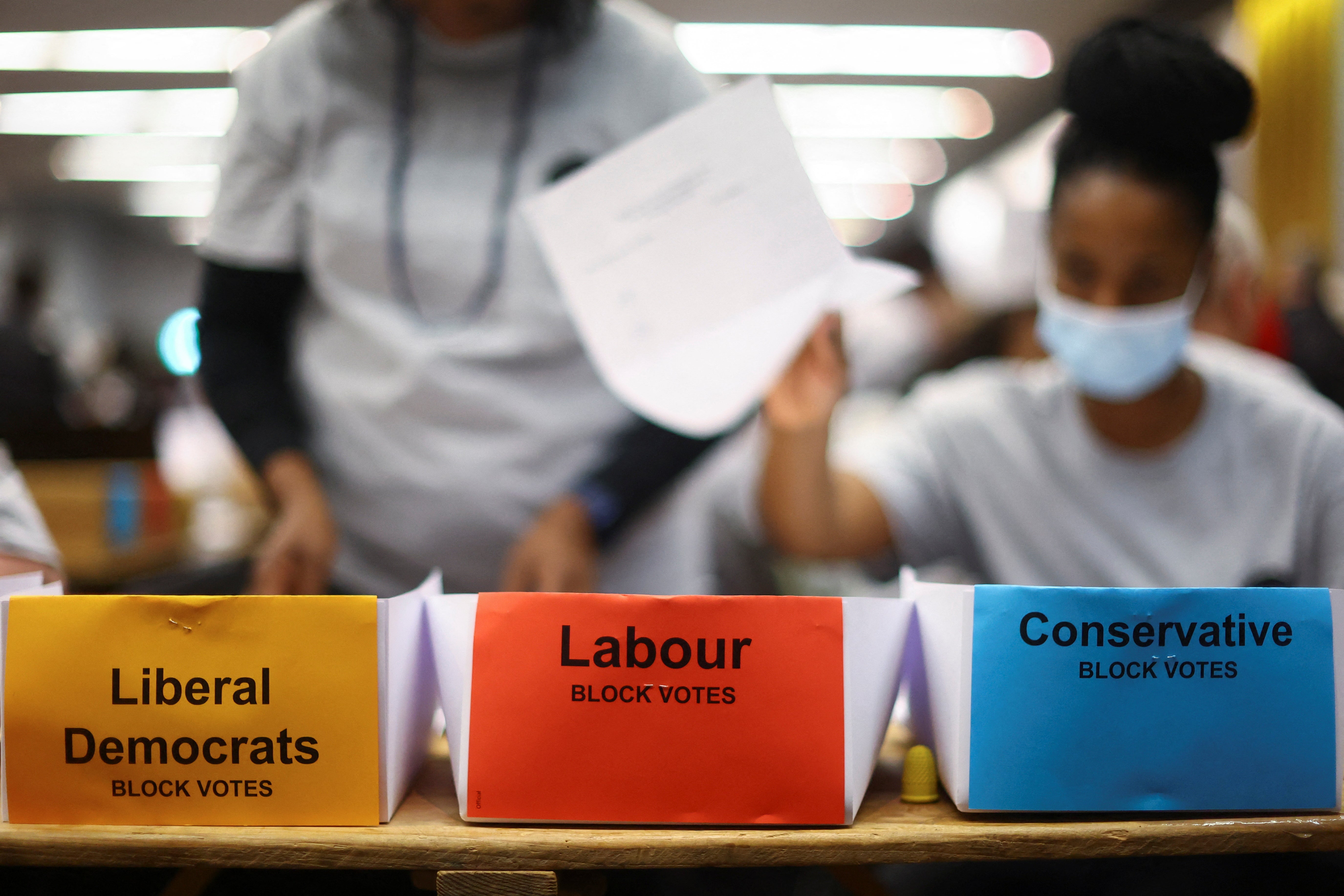A drubbing or a triumph: What do the local election results really mean?
The story of these local elections will overwhelmingly be one of Conservative decline, rather than Labour gains, writes Patrick English


Such was the order and timing with which the results trickled in overnight on Thursday, that the Conservatives were perhaps lulled into a false sense of security early on in the counting of this year’s local election results. Tory MPs in TV studios appeared visibly buoyed by the figures they were seeing in the small hours, with areas such as Amber Valley and Hartlepool even showing signs of Conservative growth, while Labour struggled to advance.
But as Thursday moved into Friday, and then Friday evening arrived, what looked to perhaps be an almost palatable set of results for the Conservatives eventually descended into a drubbing. A total of almost 500 council seat losses makes this year their second-worst performance at any local election since 1996 (the highest being 2019).
Meanwhile, the Liberal Democrats celebrated enormous success, taking well over 200 seats off their opponents to top the “seats gained” scoreboard. Similarly, the Green Party significantly grew their presence on local councils up and down the country, winning from Labour, the Liberal Democrats and the Conservatives.
Despite that, there isn’t much of a sense in which this was a Labour victory. As far as Keir Starmer is concerned, the results were very much a mixed bag.
Wins in Southampton and Wandsworth may have been at the minimum end of Labour’s expectations, and taking Westminster, Worthing, Kirklees, Rossendale and the newly established Cumberland will have added some sweetener to the leader’s Friday morning coffee.
And in Scotland, where the SNP once again reaffirmed its political dominance with increases in vote share and councillors on 2017, Labour managed the symbolic feat of finishing in second and as the largest pro-union party north of the border.
Most pleasing to Scottish Labour would have been their recovery in the most pro-independence areas of the country, suggesting potential inroads into SNP strangleholds on places such as Dundee, Glasgow and Dunbartonshire.
The party’s share of the vote increased by an average of three points in local authorities which voted by a majority for Scotland to leave the United Kingdom in 2014. Though their own vote did not grow as much in the most anti-independence authorities (up by just one point), there was nonetheless a swing to them from the Conservatives of around four points in these communities too.
There were signs that even if they did not quite see the results they had hoped for on Thursday, contests in many battleground areas are now moving in Labour’s direction. But looking past some of those notable and politically significant wins, there were not too many other positives. Labour were only able to add just over 110 extra councillors to their nationwide total on polling day, and though they were able to pick up councils in some key areas, in others they went backwards.
Most tellingly, there was no swing at all from the Conservatives to Labour in the north of England versus 2018. Against results in the 2019 local elections, there was only a meagre movement in Labour’s direction, and an increase of just 3 per cent in the region on their disastrous 2021 performance. To illustrate the point: Labour’s net total council seat gains outside London stands at just +10.
The story of these local elections, then, will overwhelmingly be one of Conservative decline – and a decline concentrated mainly in Wales and the south of England – rather than Labour gains.
Such was the cross-cutting pattern of votes and results, there is no clear, clean-cut take to provide on these elections. Not least because despite the poor overall figures, there were nonetheless some patches of notable success for the Conservatives.
Their vote held up much better in some areas of the country than others, meaning far fewer losses in the north of England for instance than the south where they were particularly routed.
And not only did they successfully mount tricky defences in places such as Newcastle-under-Lyme, Solihull and Pendle, but in local authorities such as Bolton, Gateshead, and Sunderland, they actually managed to increase their share of the vote. They even managed to pick up a London council from Labour in Harrow.
However, the BBC’s projected national share – an assessment of how the whole country might have voted if elections were held in all local authorities on Thursday – had the Conservatives on just 30 per cent, representing a drop of 5 points on 2018. Labour meanwhile was static on 35 per cent. That kind of result would see over a hundred seat losses for the Conservatives if repeated at a general election.
Voters in many traditional Conservative heartlands – the so-called blue-wall areas – delivered relentless hammer blows to the governing party on Thursday, with the Liberal Democrats taking no fewer than 40 seats and picking up two councils in the southeast alone.
Woking, Tunbridge Wells, Gosport, Wokingham and Somerset all now have Conservative MPs but councils either under Liberal Democrat or no overall control.
To keep up to speed with all the latest opinions and comment, sign up to our free weekly Voices Dispatches newsletter by clicking here
What’s more, key Conservative-Labour battleground areas across the south, such as Southampton, Portsmouth, Crawley and Plymouth, all saw swings from blue to red. London as well provided some especially sour moments – the loss of Westminster would have been a particularly bitter blow.
Elsewhere, the Welsh Conservatives experienced a hefty kicking, losing almost half of the seats they were defending. By comparison, that figure for England was only around 30 per cent. This was nothing short of a walloping in a country the Conservatives had ambitions to run just a year ago.
What might these results mean for Boris Johnson’s future as prime minister and leader of the Conservative Party? The rumour mill suggests that these results were not bad enough for an imminent ousting – and perhaps the order of declarations, masking the true extent of losses until later on Friday, helped Johnson significantly in that regard.
However, two potentially crucial by-elections await. In the six wards which make up the constituency of Wakefield, the swing from the Conservatives to Labour on Thursday was 7 per cent. While there was no election in Tiverton and Honiton, the Liberal Democrats wiped the floor with the Conservatives in the nearby Somerset unitary authority.
A loss in the red wall and in another safe Conservative heartland seat before the end of the summer could well etch the writing firmly on the walls of the flat above No 10.
Patrick English is associate director of political research at YouGov, and visiting fellow at the University of Exeter and LSE






Join our commenting forum
Join thought-provoking conversations, follow other Independent readers and see their replies
Comments